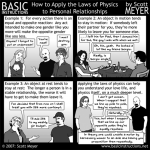Uncategorized
I'm cleaning house, and trying to write half an exam, and making a dessert to take to a friend's house tonight, and trying to reset myself. So, while I am not blogging, here is a distracting video to amuse you. Carry on.
Hat tip to one of my husband's former students, who posted it on her blog.
The Monaco Declaration (PDF) warns of the dangers to our oceans if we don't terminate the increase in CO2 in the atmosphere. The oceans are becoming increasingly acidic thanks the to rise in the levels of CO2 brought about by the industrial age. This is leading to the reduction of habitable space for coral. So, what, you say?
Details here.
[I'm foregoing the usual Saturday miscellany for a Very Special Built on Facts. It's important!]
Imagine a basketball sitting on the top of a hill. The slope of the hill is pretty gentle, and so you can roll the ball around a bit without the risk of it rolling away. But hit it too hard and it's going to catch the slope and zoom off. You and many of the materials which surround you are not so different. They're made of atoms which are comfortable so long as you don't hit them very hard. But hit them hard enough with oxygen molecules and they'll go flying away. And they'll hit other…
We have a Vermont alumnus among the ScienceBorg: Kevin Beck at Dr Joan Bushwell's Chimpanzee Refuge. He'd like to coordinate a letter-writing campaign to protest UVM's poor choice of a commencement speaker, so maybe you should go over there and leave a comment and email address.
I'm still shaking my head over this. The man's a notorious creationist and apologist for criminal Republican administrations. Why would anyone want to honor this guy? Is it for his work as a shill for eyedrops?
Pareidolia - the phenomenon where our brain is somehow tricked into recognizing vague shapes as significant features - gets mentioned now and then on ScienceBlogs. The usual trigger for this occurs when someone tries to sell the Wonderbread Virgin Mary on Ebay before the blue mold completely erases her from the slice, or when one of our more monomaniacal colleagues sees something that he can associate with the New Atheism.
Interestingly, it seems that human-programed face recognition software may be as subject to these issues as our own face recognition is. The latest version of Apple's…
Yesterday I spend a tremendous amount of time in a very snazzy lab shooting lasers through pyridine. Cool stuff, tempered by the fact that pyridine smells like what Dr. Frankenstein's lab would have smelled like if Dr. Frankenstein used organic chemistry instead of electricity, and also the thing he was trying to bring back to life was a dead fish. Science waits for no man - not at least if you have a sensitive nose. Anyway, it resulted in my super-cool post about gravity not being done yet. Blarg! With any luck I'll have it up Monday.
So as something cool for the Built on Facts show…
In his Inaugural Address, President Obama announced that he will "restore science to its rightful place." And scientists around the world wept for joy. The era of government meddling with science is over. All we need to do is fund embryonic stem cell research, take decisive action to curb global warming, protect more than three or four endangered species, reverse a couple of other little problems, and everything will be good. Right?
No.
Restoring science to its proper place in public policy does not mandate that we make any of those changes. In fact, it doesn't require that we make…
Melinda Wenner has an excellent article on the benefits of unstructured playtime - play without any rules - in the latest Sciam Mind. The article reminded me of that great Auden quote, which he adapted from Nietzsche: "Maturity - to recover the seriousness one had as a child at play."
Play actually appears to make kids smarter. In a classic study published in Developmental Psychology in 1973, researchers divided 90 preschool children into three groups. One group was told to play freely with four common objects--among the choices were a pile of paper towels, a screwdriver, a wooden board and a…
I don't normally post videos here, but when it's David Attenborough doing the talking, I'm more than happy to make an exception. This man is a legend, and has done so much to promote the majesty of nature to the entire world. He's now finished with big mega-series, but not with film-making.
This Sunday, on February 1st, the BBC will air his new one-off programme Charles Darwin and the Tree of Life". In it, Sir David candidly speaks about his views on Charles Darwin, the vital role of evolutionary theory in linking man to the natural world and how the attitudes espoused by the Book of Genesis…
For those of you that don't know, I live in Florida. Specifically, I live near Tampa - so right now life is getting a lot more difficult.
That's because the Steelers and Cardinals are in town for the Super Bowl.
And, amidst all this chaos, amusingly, I open my Google Reader this morning to see headlines like this: "Football Players Are Not The Only Ones Who Get Hurt On Super Bowl Sunday". The claim? The players are hardly the most at-risk on Sunday. The Fans are really the ones who are getting hurt - literally.
Apparently, hospitals in the area are having to brace themselves for all kinds of…
US LHC Blog » Can We âPointâ the LHC, Too?
"[C]ould we put up some kind of page where people could vote on what kind of physics we would study over the course of some particular week? Maybe a choice between searching for Supersymmetry, or a high-mass Higgs boson, or a low-mass Higgs boson? "
(tags: science physics silly internet particles)
Abstruse Goose » The Secret Lives of Photons
Life for photons can be harsh.
(tags: physics comics silly optics relativity)
The Little Professor: Just add zombies and stir
"The LibraryThing Blog kindly--or unkindly, take your pick--points us in the…
This post is part of a âglobal health blog carnivalâ effort that Christine Gorman at Global Health Report has just launched. The theme for todayâs posts is âprevention vs. treatmentâ â visit this post for links all participating posts.
Although my post focuses largely on the U.S. experience, itâs an example of a universal difficulty in justifying and funding prevention programs.
Maggie Mahar and Niko Karvounis have posted some disturbing news at their Health Beat blog: The war against tobacco is slowing down. Many strategies that have helped lower the U.S. smoking rate to under 20% (…
by revere, cross-posted at Effect Measure
A powerful Editorial in today's Nature (the world's premier science publication) shines a strong light on a tragic violation of human rights in Iran involving two leading AIDS physicians, brothers Arash and Kamiar Alaei. We've posted about it twice (here and here). Declan Butler, a senior correspondent at Nature summarizes the story over at his blog:
Iran has sentenced two of the countryâs HIV researchers to prison for communicating with an âenemy governmentâ and plotting to overthrow the state. Arash and Kamiar Alaei, who are brothers, underwent a…
I've got an interview with Ed Vul, the lead author of the recent paper on "Voodoo Correlations in Social Neuroscience," over at Scientific American. Since the paper hit the web, it has provoked a flurry of rebuttals and responses. If you'd like a balanced perspective on the issue - and it's worth pointing out that this issue isn't unique to social neuroscience, but has implications for fMRI research in general - I'd suggest reading the interview and then perusing this eloquent and fiery response by Matthew Lieberman, Elliot Berkman and Tor Wager.
LEHRER: Your paper has prompted a great deal…
The Second Law of Thermodynamics probably produces more confusion in the general public than most other physical laws that have percolated themselves into the collective consciousness. Not the least of these are all the seemingly disconnected ways of saying it, which vary in accuracy. Disorder increases. Absolute zero is impossible. Engines can't turn heat into work with perfect efficiency. Things fall apart, the center cannot hold, mere anarchy is loosed upon the world...
Well maybe not that last one.
Probably the version that both makes the most sense and is the most accurate is one…
I've got a long article in Nature this week on Jeff Lichtman (of Brainbow fame) and the birth of connectomics, which seeks to construct a complete wiring diagram of the brain:
At first glance, Jeff Lichtman seems to be hanging long strips of sticky tape from the walls of his Harvard lab. The tape flutters in the breeze from the air-conditioner. But closer inspection reveals that this is not tape: it is the brain of a mouse, rendered into one long, delicate strip of tissue and fixed onto a plastic film. When the film is tilted to the light, the tissue becomes visible, like the smear of a…
There are 10 new articles in PLoS ONE today. As always, you should rate the articles, post notes and comments and send trackbacks when you blog about the papers. You can now also easily place articles on various social services (CiteULike, Connotea, Stumbleupon, Facebook and Digg) with just one click. Here are my own picks for the week - you go and look for your own favourites:
Rhythmicity in Mice Selected for Extremes in Stress Reactivity: Behavioural, Endocrine and Sleep Changes Resembling Endophenotypes of Major Depression:
Dysregulation of the hypothalamic-pituitary-adrenal (HPA) axis,…
I am not usually the type to put pictures of cute animals up. I leave that to Cute Overload. I don't really even like animals. (I know...shameful coming from a biologist.)
But this otter is so cute it...it just defies description.
It was rescued from abandonment in Scotland. Frankly, it makes your average puppy look like a big, fat sack of crap. It is like they distilled cute into an absinthe-strength cute beverage -- a beverage that will make you wake up the next day and never want to drink cute again.
This otter makes you sad to be a member of the human species, doomed to produce…

